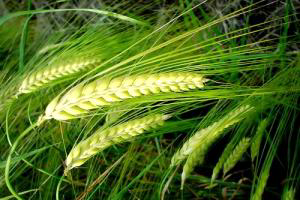UK: Barley, oilseed rape – early harvest looks positive

The stop-start harvest is set to pick up speed this week as showers make way for sunshine with yields of early-cut winter barley and oilseed rape looking encouraging.
Rain halted many combines early this week with winter barley crops harvested showing yields averaging around a respectable 7.5t/ha.
With only about 5% of the winter barley crop cut and even less oilseed rape, early reports point to a harvest of better yields than expected considering the poor state of crops earlier this year.
Grain traders say with drier weather forecast later this week and into the weekend, the winter barley harvest could soon really get under way across most of England.
Although with winter wheat some way off harvest, and a lot of spring barley and rapeseed being sown they warned that combines could keep rolling well into September.
Those crops cut so far have largely been sown early and established well before the wet and cold winter and the grains had largely filled before the summer heatwave.
Somerset
Somerset grower Archie Montgomery has cut around half of his 50ha of winter barley with a yield of 8.75t/ha, matching average historic yields for his farm.
His barley was helped by a low disease year and good light levels this season, while the grains were largely filled before the dry weather arrived.
“Yields of any crop that has not given up, or grown on very stony land, are going to be OK,” he says.
He is growing California and Cassia winter barley at his 600ha Manor Farm in North Cadbury, five miles west of Wincanton, but he will have to wait another two weeks for later-sown barley or green-looking headlands.
Oilseed rape is set to be desiccated this week on the farm and winter wheat looks likely to be ready to harvest along with oilseed rape in around two weeks’ time.
Yorkshire
Up on the Yorkshire Wolds, Matt Hiles cut nearly half of his winter barley with a yield of 9.3t/ha and quality looking good before rain.
Mr Hiles, back on the L Hiles and Sons family farm near Market Weighton in East Yorkshire between terms at Bishop Burton College, cut around 15ha of the farm’s 35ha of Volume winter barley.
“The awns have been a bit tough, so it’s taken some threshing, but the sample has been good and moisture content was around 16%,” says Mr Hiles.
Across the family farm’s 178ha of combinable crops, winter oilseed rape and winter wheat are looking promising after a difficult season.
“We’ll aim to finish off our winter barley when it dries, with winter oilseed rape still a week or ten days away from being ready,” he says.
“We also contract combine up to 600ha locally and hope to start moving into our customers’ crops by the weekend of 3 August if the weather is kind,” he adds.
It has been a frustrating harvest so far for Martin Meadows near the Suffolk coast with only some of his winter barley and oilseed rape cut on his lightest land.
The RG Meadows and Son family farm in Carlton Colville, just south of Lowestoft, share farms around 285ha of combinable crops with GW Winter and Son just down the road at Gisleham.
He has started cutting winter barley with a respectable yield, but has been held up by rain.
“We have managed around 15ha of SY Venture at Gisleham, which has yielded 7.7t/ha at 14.7% moisture, but it looks like the showers will stop us today (30 July),” he adds.
Combining days are short on the coast, with damp sea breezes often resulting in late starts and early finishes.
“It looks like everything will come at the same time, so it could be an interesting drilling campaign trying to get everything turned around in good time,” he adds.
West Norfolk
In west Norfolk, farming group Sentry has cut nearly 25ha of Flagon winter barley on light land near Downham Market, with the malting variety yielding around 6.5t/ha at 15-16% moisture.
The company is hoping to cut more when crops dry out after recent rain, but winter wheat and oilseed rape is looking around 10 days off harvesting.
Only a handful of very early oilseed rape crops have been harvested, with much of the national crop two weeks from seeing a combine.
“At this stage last year we would have been moving thousands of tonnes of rapeseed. This year we are only seeing lorry loads,” says Owen Cligg, trading manager at United Oilseeds.
One grower to get going early is James Faulkner, who has been harvesting oilseed rape on his contract-farmed land belonging to Paul Jowers on Mersea Island, just south of Colchester in Essex.
His 35ft cut John Deere S680i combine started rolling last Wednesday and has so far cut around 72ha at a moisture content of between 10-12%.
“We have taken the opportunity to get as much done as possible, despite the moisture content being a little high,” says Mr Faulkner.
The variety ExPower is yielding a promising 4.5t/ha and has been combining well, he adds.
Mr Faulkner was eager to get started on some of his 1,100ha of combinable crops as he has no winter barley in the ground.
“It was one of the earlier drilled crops on 28 August and has looked good all year. Any crops that were much later suffered a bit more,” he says.
He hopes to get around half of his oilseed rape area complete before moving into his breadmaking wheat.
Back on the Suffolk coast, Mr Meadows has made a start combining the oilseed rape variety Camelot on his sandy land while some of his 81ha is still to be desiccated.
“It’s a low-biomass variety, so combined really well and was yielding around 3.9t/ha at 9% moisture.
“The sample was good, with not too much red seed, but the grain size was a little smaller than last year,” says Mr Meadows.
Source: David Jones, Farmers Weekly








